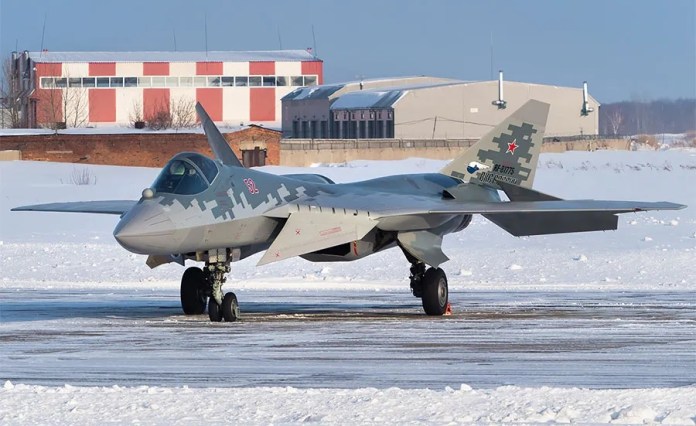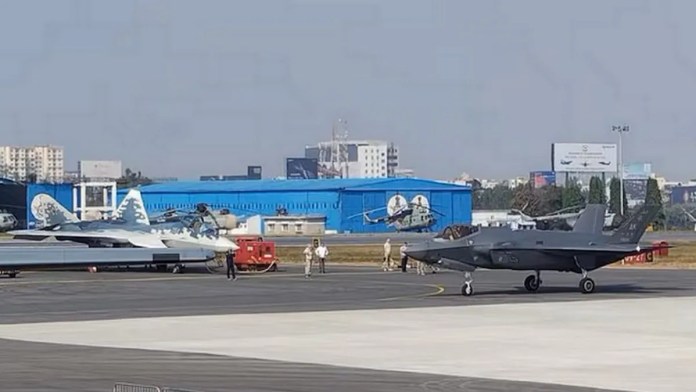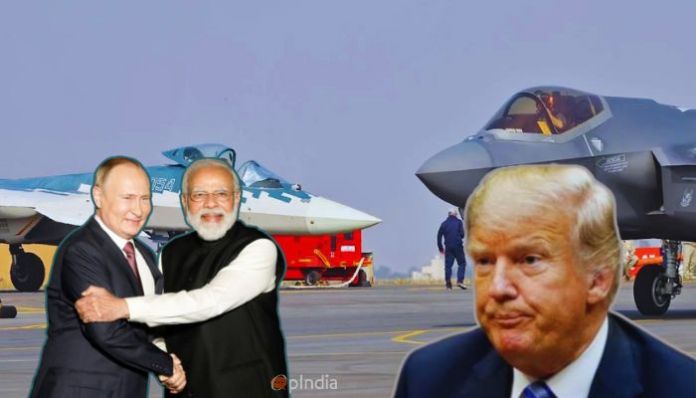


In a high-stake chess game of military modernisation and geopolitics, India is reportedly actively considering Russia’s proposal of supplying the Sukhoi Su-57E fifth generation aircraft and make the same in India. While India is reported not be heeding American offer to buy the F-35 jets, a question arises that why India is not showing interest in acquiring F-35, which is touted as the crown jewel of Western defence.
India’s tilt towards acquiring Russian Su-57E over American F-35, is not a matter of mere procurement choice, rather, it is shaped by decades of trust in Moscow’s defence partnership and key offer of technology transfer against the US delivery delays and disregard for strategic defence autonomy of the importer nation.
As Pakistan and its foster father China are deepening defence ties, especially in context of advanced stealth fighters after India’s successful Operation Sindoor, India’s pivot towards Russian Su-57E comes across as a mover towards securing its skies while also asserting its quest for self-reliance in a globally volatile global order.

However, before delving into whether India should go for Su-57 or F-35, it is essential to understand why India needs to immediately modernize its Air Force.
Why India must modernise its Air Force
While India Air Force (IAF) successfully carried out anti-terror Operation Sindoor in Pakistan, demonstrating sheer tactical brilliance, the IAF is grappling with a shortfall in its fighter jet capabilities. Currently, the operates 31 squadrons, which is significantly below the sanctioned strength of 42, at a time when India’s cash-strapped neighbour Pakistan is in panic mode and set to acquire Chinese J-35 stealth fighters.
Besides, India is also phasing out its ageing fleet including MiG-21, Jaguar and Mirage 2000 fighters, and India needs to diversify its fleet by not relying only on French Rafales. The delays in indigenous programs like the Tejas and the Advanced Medium Combat Aircraft (AMCA), exacerbate the urgency to purchase fifth-generation fighter to bridge the capability gap.
Notably, DRDO is developing the fifth generation AMCA fighter jet, but this project is not expected to be completed before 2035. With Pakistan set to start receiving China’s J-35A 5th-Gen multirole stealth fighter this year itself, 10 years will be a too long wait for Indian Air Force for its own 5th generation stealth fighter jet.
Since Pakistan’s de facto ruler—the Pakistan Army—has increased defence budget by 18 to 20 per cent even as the hostile neighbour is dependent on IMF loans for sustaining it’s dwindling economy and balance-of-payments, it is evident that they are preparing for another round of conflict with India in the near future.
Notably, while DRDO has started developing the AMCA, the first jets are not expected before 2035. After completing the order of Tejas LCA Mark-1 aircraft, HAL will start making the Tejas LCA Mark-1 aircraft from around 2028-29, and the first generation of AMCA will take more than 10 years to reach the production stage. This is because, any fighter jet takes around 10-15 years to develop, and the AMCA was approved just last year.
Why purchasing American F-35 makes no sense for India
India is among the major countries which procure defence items from both Russia and the United States. While Moscow has been India’s most trusted defence partner, the US uses defence deals as means to arm twist India into aligning to its interests. India has faced significant delays in the delivery of US-made defence equipments, especially the General Electric (GE) F404 engines for the indigenously developed Tejas Mk-1A light combat aircraft.
The deal for GE F414 engines for Tejas Mk-2 fighters is also not progressing, even though the MoU was signed two years ago. The deal is set to include technology transfer and manufacturing in India. With president Trump’s insistence on manufacturing in USA, it is not sure whether he will allow these provisions to be implmented. He has already asked Apple to not phones in India, therefore, the possibility of him allowing making GE engines in India may not be very high.
Moreover, the US has also been delaying the delivery of Boeing-made Apache attack helicopters meant for the Indian Army. In March 2024, the Indian Army raised a squadron 451 Army Aviation Squadron at Nagtalao near Jodhpur, in anticipation of the delivery of Apache helicopters, however, the US delayed it citing supply-chain disruption and technical issues. The delivery was expected in May-June 2024 but it was delayed to December 2024 and even that deadline was missed by the United States.
This $600 million deal was signed in 2020 for six Apache helicopters, while two deadlines have been missed for the delivery of the first batch of three helicopters, the US has not given any clear indication regarding when will these heicopters delivered and the reason behind this disproportionate delay.
While the US gives ‘supply chain disruption’ and ‘technical issues’ as the excuse behind the delay in delivery, it is their typical arm-twisting tactic. These delays are caused deliberately to exert pressure on India. The delay comes at a time when the Indian Army Aviation Corps is rapidly modernising its aerial assets. With heightened military tensions post Operation Sindoor, India is focusing on combat readiness, and for that, Apache helicopters are crucial since these are equipped with advanced weapon targeting mechanisms and heavy weaponry. However, the US is not prioritising its delivery to India and is missing deadlines one after the other.
Russia, in contrast, has quite a punctual track record of delivering critical defence equipment to India even in the face of geopolitical challenges, making Su-57 a more predictable option for timely induction.
The US causing deliberate delays, however, is not surprising since its foreign policy has been to bomb, threaten, sanction, and bully nations, trigger conflicts, and conduct regime change operations when things do not go their way. No wonder Henry Kissinger once said, “It may be dangerous to be America’s enemy, but to be America’s friend is fatal.”
Interestingly, while Donald Trump may have unleashed ‘trade deal’ as his magic wand of settling conflicts, considering its failure in the Ukraine-Russia war and the India-Pakistan conflict, it is as effective as UN has been in ending the Israel-Palestine war.
Besides the continued trust and mutual respect between India and Russia as defence partners, one of the most compelling aspects of Russia’s Su-57 offer is its alignment with India’s Make in India and Atmanirbhar Bharat intiatives, which prioritises indigenous defence manufacturing. Moscow is reported to have offered deep localization of Su-57, including co-production at Hindustan Aeronautical Limited’s manufacturing facilities, especially where Su-30MKI is already manufactured.
In addition, Russia has also offered full technology transfer, allowing India the integration of its own systems like GaN-based AESA radars, Indian-developed mission computers as well as native weapons like the Astra missile and Rudram anti-radiation missiles. Not only that, Russia has also offered full access to the source code of the Su-57, which can tilt Indian decision in its favour. On 4th June, Russian state-owned United Aircraft Corporation announced that the proposal to build the Su-57 in India includes an unprecedented full access to the aircraft’s source code.
However, if we look at the USA’s approach, it has a history of restricting technology transfer for the F-35 to even its allies like Israel, Japan, Australia and Italy among others. The proprietary systems of F-35, including its software and hardware, are strictly controlled. Moreover, the United States does not allow buyers to manufacture the jet or integrate non-NATO weapons without explicit approval. This apparent inflexibility limits India’s ability to adapt the F-35 to its unique operational requirements and induct indigenous technologies, even as it is an unavoidable concern for India since it is seeking to curb reliance foreign suppliers or at least limit it only reliable partners. Under Trump, it is highly unlikely that US would agree for a technology transfer arguing that it would compromise America’s tech superiority.
Notably, the American F-35A costs around $80-$110 million per unit, while, the Su-57 costs around $35-$40 million. In addition, the maintenance cost of the Russian stealth fighter jet is comparatively lower than that of F-35.

Besides, reports suggest that F-35 also has certain technical issues. “Stealth coating, sustained supersonic flight, helmet-mounted display, excessive vibration from its cannon and even vulnerability to being hit by lightning,” a Business Insider report from 2023 states.
The American F-35 are also reported to be vulnerable to hacking. In 2015, a German magazine reported that the NSA intelligence contractor and whistleblower Edward Snowden’s leaked documents stated that the Chinese hackers stole around 50 terabytes data of Australia’s US-made F-35. The hackers accessed F-35’s radar systems, engine schematics and methods to track targets. Perhaps that’s why Chinese J-35A and American F-35 have uncanny resemblance.
To deploy the F-35, India will need to purchase the AIM-120 advanced medium-range AAM since it will require US approval to modify the aircraft to carry indigenous and non-NATO missiles. Additionally, the IAF already has seven different combat jets: the Tejas, Rafale, MiG-21, MiG-29M, Sukhoi Su-30MKI, Mirage 2000-5, and SEPECAT Jaguar. The cost of maintaining seven different sorts of jets is way too high. Investing in an expensive fifth-generation American fighter will be a logistical headache, adding to the IAF’s problems with overhaul, maintenance, and repairs. While Su-57 is also a different jet, given that it is a Sukhoi variant, maintanence is expected to be cheaper and adaptibility will be easier.
Besides the technical aspects, it is important to understand that India’s defence procurement-related decisions are influenced by geopolitical considerations, especially the risk of US sanctions through the Countering America’s Adversaries Through Sanctions Act (CAATSA). Not to forget, India had upset American in 2021 with the purchase of Russia’s S-400 air defence system. India, however, navigated its way out of USA’s sanction threats as well as threats of deliberate delays in future arms transfers, and purchased Russian S-400s.
US also objected to India buying Russian oil after the Russia-Ukraine war, and had again threatened sanctions.
The United States has a history of imposing export controls, and embargoes to protect its defence technologies, this would obviously complicate India’s access to F-35 spares and maintenance support, particularly in crisis. Previously, the US has delayed or withheld defence supplies to countries it believed as misaligned with its strategic priorities.
As mentioned earlier, the United States uses these delay tactics to arm-twist buyers into falling in line with US’s interests. The US’s reliability as a defence partner also becomes questionable when on one hand it arrests Pakistani nationals for plotting terror attacks on American soil, on the other, lauds the same country as ‘phenomenal partner’ in countering terrorism, refuses to relinquish its relations with Pakistan even at the cost of upsetting India. Since India emphasizes its strategic autonomy and unlike Pakistan, refuses to be anyone’s puppet, it cannot rely on any single supplier, thus, Russia’s Su-57 is a better option with fewer geopolitical strings attached.
There is no doubt that India needs to curb its foreign dependence for defence requirements, however, India’s partnership with Russia has been time tested. Around 60 per cent of India’s military hardware, including BrahMos missiles, Su-30MKI, S-400, T-72 tanks are of Russian origin. Russia has been quite flexible when it comes to critical support, technology transfer and co-production, something the US refuses citing ‘security concerns’.
The Su-30MKI, a customized version of Russian Su-30, is literally the backbone of the Indian Air Force, with more than 260 units in service. Its successful production at HAL’s Nashik facility demonstrates the strength of Indo-Russia defence partnership. Russia’s offer to leverage existing infrastructure in India, ensures a smoother transition and lesser logistical challenges when compared to inducting American F-35, which would require entirely new training and maintenance ecosystems.
As discussed above, Russia’s reliability during critical times even if we go as back as 1971 Indo-Pak war, contrasts with the US’s tendency to play ball India. The US has supplied India with C-17 Globemaster and Apache helicopters earlier, however, deliberate delays in critical components and strict export controls create obvious trust issues.
The Russian fifth generation stealth fighter jet is not only cheaper than F-35, but also aligns better with India’s defence budget constraints and would allow larger fleet acquisitions. In addition, Su-57’s design emphasizes high manueverability, supercruise, and multi-role capabilities which are more suited to India’s requirements for tackling diverse threat scenarios such as high-altitude operations along the China border. The F-35 on the contrary, is more optimized for network centric warfare, thus it may not entirely meet India’s need for standalone operations.
Also, with fast changing global alliances and loyalties, India would not want appear too closely aligned with NATO, especially at a time when Russia is at war with a NATO-backed Ukraine. Moreover, since Russia offers co-production of the Su-57, this could position India as a regional exporter of advanced fighters, giving a massive boost to Indian defence industry, especially when the world is increasingly taking interest in buying India’s battle-tested weaponry. The F-35, on the contrary, would offer no such scope due to export restrictions by the US.
Conclusion
Until indigenous defence programs like the AMCA come to fruition, India would want to go for a foreign alternative for its requirement of fifth generation fighter aircrafts. However, India should focus on cost-effectiveness, operational compatibility and timely acquisition, all of which are better offered by India’s most trusted defence ally Russia. The existing infrastructure, Russia’s willingness for technology transfer and continued respect for India’s strategic autonomy make Su-57 a better option against America F-35.
In defence sector, imports should be an exception and not a norm; however, to bridge the fifth generation gap until indigenous AMCA is ready, India should rely on traditional defence partners like Russia instead of the US. This becomes crucial especially because of US President Donald Trump’s tilt towards Pakistan for his self-interests including his cryptocurrency-related ambitions and to evade USA’s arm-twisting tactics. After all, how long will India carry the burden of the US’s ego and interests at the cost of its own strategic and defence autonomy?
















































